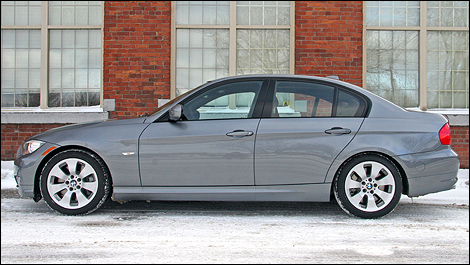Aqueous urea (known as AdBlue in Europe) contained in two seperate tanks (including a heated one) is used independently from the driver's control. In normal driving conditions, filling up these tanks should coincide with a regular maintenance schedule.
Inspiring performanceLongtime diesel fans will be disappointed to learn that, similar to the TDIs from Volkswagen, the engine of the BMW 335d has eliminated the traditional reverence to Rudolf Diesel. You know, these few seconds you had to wait patiently to let the combustion chambers warm up before firing up the engine. The 335d starts in a flash as soon as you push the red button. Sorry, Rudolf!
In fact, the 335d won't be marketed as an economy car. Given the company's sporty reputation in North America, BMW will instead put an emphasis on the surprising performance delivered by the engine. Write it down: the 335d is a performance sedan. And after a quick road test, I can tell you it could even be described as a hot rod!
 |
| Write it down: the 335d is a performance sedan. |
Consider this: the engine produces 265 horsepower, allowing 0-100 accelerations in just 6.3 seconds (barely four tenths of a second slower than a 335i with manual transmission).
This ultra-torquey monster (425 pounds-feet at 1,750 rpm!) is remarkably flexible thanks to a pair of sequential turbochargers. As is the case with Volvo's force-fed engines, accelerations are instantaneous and, more importantly, very linear. Here, turbocharging causes no awkward jolt.
Between 800 and 1,500 rpm, the smaller, low-inertia turbo works alone to boost power. Then, as the engine revs up, the larger turbo steps into play. They team up to about 3,000-4,000 rpm, at which point the big turbo takes care of all the force-feeding.
Yet, despite all this action, the 335d makes less stops to fill up. The company claims a combined city-highway fuel economy rating of 7.1 liters per 100 kilometers (versus 9.9 for the automatic 335i). Even after a short road test in winter conditions, I wound up with an average of 7.2 L/100 km.
It's no wonder the 2009 BMW 335d finds itself among the most environmentally-friendly cars in Canada!
Photo Credit : Luc Gagné
